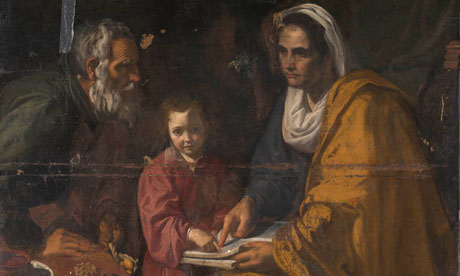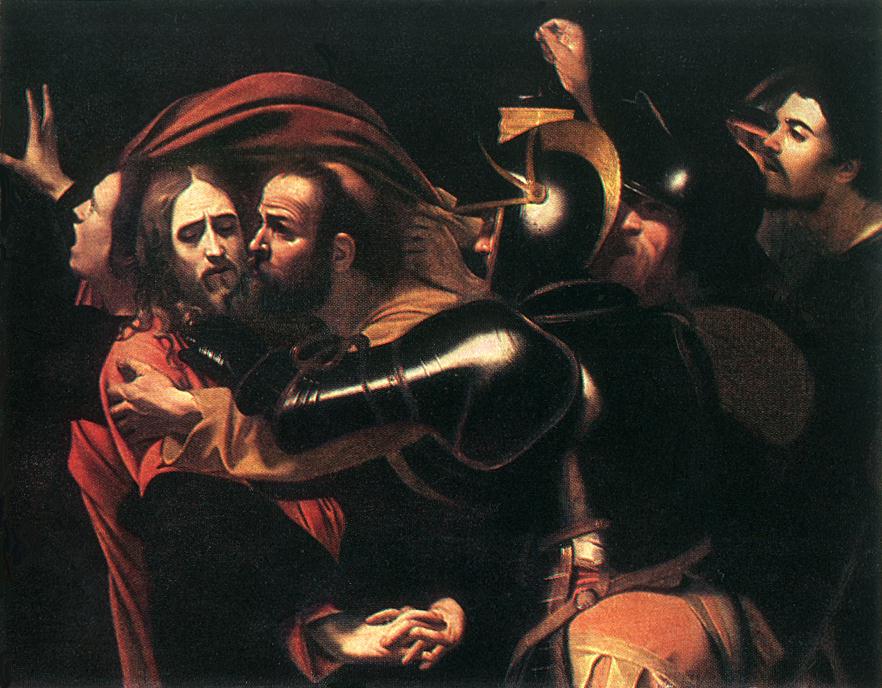Tuesday, August 10th, 2010
I came across this stunning image of from the back of King Tut’s gold throne (left, c. 1332-1322 BC) tonight. Isn’t it gorgeous? (Click on the image to enlarge it, if you don’t believe me.) I love the striking, bold colors. And I especially love that Tutankhamun is depicted with the lil’ Amarna-style belly that his dad popularized in Egyptian art (see the relief Ahkenaten and His Family, c. 1353-1336 BC, for one another example of the Amarna style).
This throne shows Tutakhamun being anointed with perfume by his wife, Ankhesenamun. I love the fine details in Ankhesanumun’s robe, and I especially love that you can see the outline of her legs beneath the flowing material. It gives the impression that the material is very lightweight. (There is a little more information about this throne here.)
Speaking of King Tut, have you seen the reconstruction of his face? In 2005, National Geographic reported that scientists used 3-D CT scans to reconstruct the first mummy of the ancient pharaoh. Kinda cool, but also kinda creepy. Check out this image of the bust on display at the Field Museum in Chicago – it totally reminds me of the heads that the witch Mombi stored in the “Return to Oz” movie. Yikes!
Friday, August 6th, 2010
My friend Jon just sent me this article. I was glad to see that admission is free to this museum – it would be entertaining to visit, but I wouldn’t want to pay anything in order to see “bad art!”
It sounds, though, like this museum is able to turn “bad art” into something somewhat positive (gasp!) and entertaining. I enjoyed the quote in the article by Louise Reilly Sacco (the co-founder of the museum): “We celebrate these pieces, and we enjoy them. Once you get beyond the name of the museum, we never say bad things about them.”
What do you think? Do you think it’s right for someone to stipulate if art is “bad?” (I don’t have a problem with it, but I could see how such an idea could be controversial.) Would you visit such a museum? Would you pay for admission?
*You can check out the website for the Museum of Bad Art (MOBA) here.
Wednesday, July 21st, 2010
My friends, we either live in a very fruitful time for artistic discoveries, or something is out-of-whack. Has anyone paid attention to how many works of art that have been recently discovered? Just within this past year, there have been several works of art (or art-related discoveries, like Caravaggio’s bones) that have been brought to public attention. I’m sure that I haven’t posted about all of the discoveries made within these past few months, but here are a couple that I pulled out of my archives (noted with their post date, not the discovery date):
October 2009: “La Bella Principessa” attributed to Leonardo (via fingerprinting)
November 2009: Raphael Copy Discovered in Apartment
January 2010: Rembrandt Discovered in Bathroom Cabinet
May 2010: Possible Raphael Found in Modena
June 2010: Caravaggio Bones Discovered

And now, just as of this month, there are two more possible discoveries to include in the list. The Vatican recently reported
the possible discovery of a new Caravaggio painting, the
Martyrdom of St. Lawrence (see right). I have to admit, I’m quite skeptical about this new “discovery.” Although I haven’t seen the painting in person, some of the things look a little “off” to me. I think the treatment of the blue drapery is a little unrefined, as well as the rendering of Lawrence’s left arm and right hand. But who knows? I could be wrong. I’m a historian, not a connoisseur. Maybe I’m just skeptical as to why the Vatican is announcing this timely “discovery” during the celebrations marking the 400th anniversary of Caravaggio’s death. It seems a little too convenient, and I wonder if people are getting too hyped-up over Caravaggio to think sensibly.

The other work of art recently “discovered” was found in the basement of Yale University Art Gallery (see left). The
Guardian reports that this battered canvas, which was located in the museum basement, has now been attributed to Velasquez. The Prado Museum is reserving judgment on the painting, and I’m tending to do the same. When I read that this painting was discovered in the museum basement, I sarcastically thought, “
Of course. Of course it was discovered in the basement.” Maybe I’m too skeptical, but it seems like all museum directors would be interested in rummaging through their basement storage right now, ever since a possible Raphael was discovered in storage this past May.
What do other people think? Are you beginning to get skeptical of these discoveries? Or are you happy to embrace discoveries with open arms? I sure like the idea of paintings being discovered, but starting to get a little wary…
Friday, July 2nd, 2010
Earlier this week I posted about a stolen Caravaggio painting, The Taking of Christ (“The Kiss of Judas”) that was recovered in Berlin (see above (and note damage incurred by theft!)). However, a lot of debate has occurred this week as to the authenticity of this painting, which originally was housed in the Odessa Museum of Western and Eastern Art (Ukraine). As reported here, it is very likely that this this recovered “masterpiece” is actually a contemporary copy from the 17th century. Experts argue that this copy was probably created 20 or 25 years after Caravaggio’s original painting of c. 1602.
In truth, the authenticity of the Odessa painting and another version of the painting (located in Dublin) has been disputed over the years. At this point, most experts agree that the Dublin painting is an original work by Caravaggio. In fact, the Odessa painting was only authenticated as recently as 2005 (it had long been considered a copy, but was authenticated while it was on exhibit in Spain). In a twisted way, I guess it’s good that this Odessa painting was stolen: the events have afforded experts another chance to reexamine this work. Although I haven’t examined the painting for myself, I have a feeling that this new (and not-so-new) opinion of the painting is correct. I think that it’s a copy. Although I don’t know the specifics regarding the 2005 authentication, it seems like someone (a Spaniard?) was a little too hasty and a little too determined to authenticate the Odessa painting. And hey, I can’t blame that person too much. I would want to authenticate and “discover” a work by Caravaggio, too.
Obviously, it’s hard for the Odessa museum to accept this new opinion. No one wants to hear that their prized piece is no longer a masterpiece (and also not worth the previous estimated value of $100 million). I guess that by now the thieves have heard this news, as well. How ironic: they went through all of that trouble to steal a fake.
Wednesday, June 30th, 2010
Caravaggio continues to make headlines this year (which celebrates the 400th anniversary of Caravaggio’s death). You may have noticed my recent tweet that scientists believe that they have found Caravaggio’s bones (see left). This is really exciting news, although I wish that we could determine the exact cause of Caravaggio’s death through analysis of these bones. If only bones could talk…
In other exciting news, Caravaggio’s painting The Taking of Christ (also known as “The Kiss of Judas,” c. 1602, see right) was recently recovered (see here). This painting was stolen from Ukraine two years ago, and it recently appeared in Berlin. Two thieves have been apprehended; they apparently tried to sell the painting to a German collector. The recovery is really exciting, but its really disheartening to see the damage incurred by the theft (see image of the damaged canvas at the end of this post).
(FYI: There is another version of The Taking of Christ which is located in the National Gallery of Ireland, Dublin. Don’t be confused if you’re recently seen this painting on display!)
UPDATE: This recovered painting has been reexamined by experts and determined to be a 17th century copy of Caravaggio. See this post for more information.




